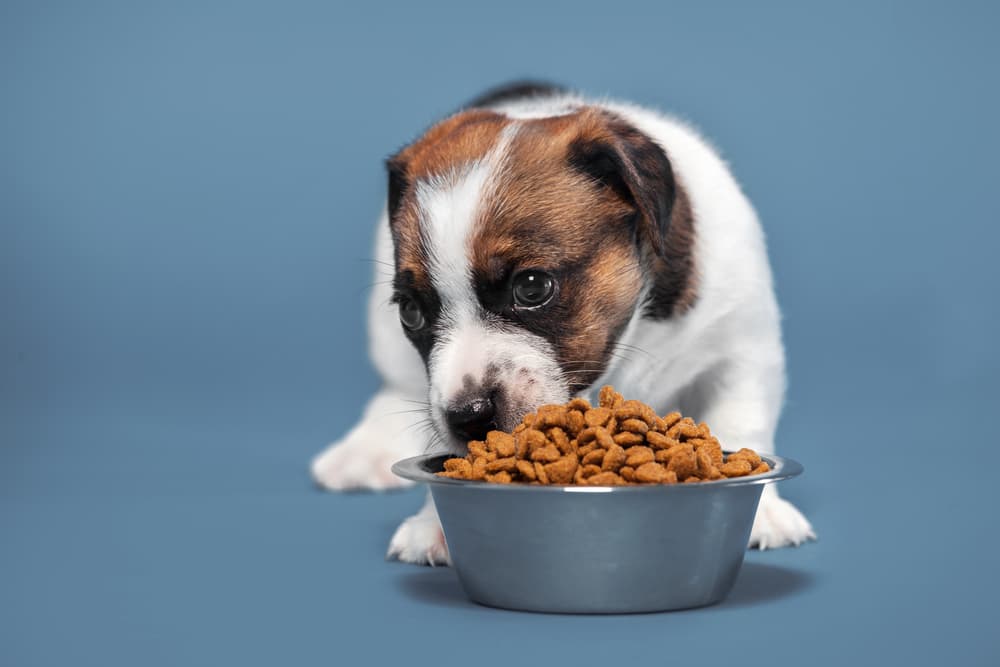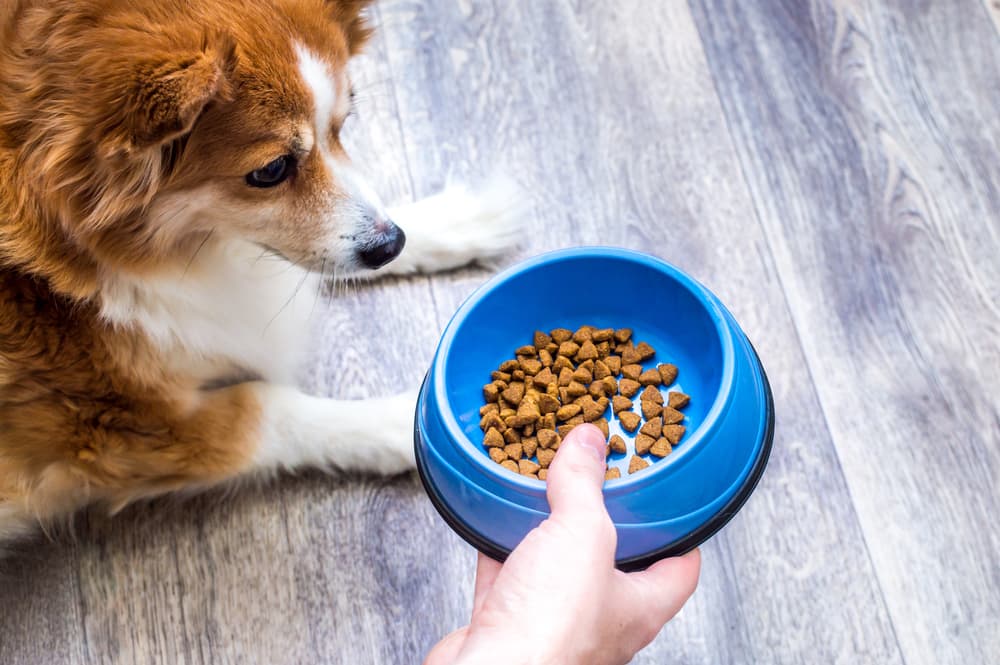7 Dog Food Mistakes You Might Be Making

How do you feed your dog in the best possible way to help them live a healthy, happy life? This is a question many pet parents ponder as they scan the dog food aisle or browse the internet for advice.
With so many choices available, it can be hard to know if you’re making the right dietary decisions for your dog — and there are several pitfalls pet parents can fall into when it comes to feeding their pets.
Great Pet Care spoke with two experts about typical dog food mistakes: Dr. Gabrielle Fadl of Bond Vet in New York City and Dr. James Cellini of Ocean State Veterinary Specialists in East Greenwich, Rhode Island. Here’s are their thoughts:
Mistake #1: Falling for Marketing Traps
Dr. Fadl says one of the most common mistakes pet parents can make is to select dog food with savvy marketing but without nutritional claims that can be verified.
“What you realize very quickly when you’re going to look for a pet food is that there are hundreds and hundreds of options and not a ton of information that’s reliable,” says Dr. Fadl. “Any person or group of people can come together and create a diet and sell it on the market, and they don’t need to pass any guidelines or standards in order to produce that diet. So they can claim lots of things such as being natural or holistic, and none of it actually means anything.”
Dr. Fadl says to look for veterinary-formulated dog food, which generally means that a veterinarian or veterinary nutritionist has approved the food for its nutritional content. She says you can also look for dog food with a nutritional adequacy statement from the Association of American Feed Control Officials (AAFCO), which ensures the quality and safety of dog food.
Of course, it’s also helpful to check in with your veterinarian or a veterinary nutritionist about your dog’s diet, especially during puppyhood and older adulthood, says Dr. Fadl. She says you should also seek dietary advice if your dog is experiencing gastrointestinal issues, itchy skin, or another problem.
Mistake #2: Not Feeding For Your Dog’s Life Stage

Puppy food, adult food, senior food — do these labels matter?
Dr. Fadl says it is essential to feed your dog food appropriate for his or her age.
“Their nutritional needs change as they grow,” says Dr. Fadl. “Puppy diets also tend to be more fatty and more calorie dense, and so feeding an adult dog puppy food will oftentimes result in a pretty chubby dog fairly quickly.”
Dr. Cellini agrees that it’s necessary to get your dog food tailored for his or her age — but adds that you shouldn’t stress if you’re a few weeks or months past the recommended range.
“I would not worry about that one,” he says. “What’s more important are the extremes. I wouldn’t give a 14-year-old dog 6-month-old puppy food.”
Mistake #3: You Give Your Dog Too Many Table Scraps or Treats
You’re eating dinner. Your dog plops down beside you and gives you puppy-dog eyes you can’t resist.
“I’m certainly guilty of treating my dog to a little something of what I’m eating,” says Dr. Fadl, “of course, making sure that it’s safe and not a toxic food, but you know in general I think a little taste here and there is okay.”
But what and how much you give your dog matters significantly. It’s important to research and avoid toxic foods (like chocolate and grapes), while giving all treats in moderation.
“I would stick to tiny small amounts as a little treat,” she says. “Just like us, when the majority of your diet is becoming donuts and sweets more so than healthy balanced foods, that’s when it really becomes a problem.”
Regarding commercially-sold treats, Dr. Fadl recommends that pet parents follow the daily recommended amounts to give their dogs.
If your dog does get too many table scraps or treats, he or she risks becoming obese, which can lead to other health problems, says Dr. Cellini.
“When you’re giving them these treats left, right, and center all day those calories add up,” says Dr. Cellini. “And it’s not too dissimilar from me or you just adding in a couple of Snickers bars every day.”
If you cannot control how many treats your dog is getting — for instance, if a child in your household gives your dog more than he or she should — you can cut down on how much food the dog gets at meals, says Dr. Fadl.
Mistake #4: You’re Generally Overfeeding Your Dog
In addition to not giving your dog too many treats, you shouldn’t give him or her too much food at mealtime. According to a 2018 survey conducted by the Association of Pet Obesity Prevention, almost 56 percent of dogs are considered obese — and overfeeding is often to blame.
“It’s really important to maintain that ideal body weight in our dogs,” says Dr. Fadl. “They are susceptible to all the same illnesses people are with being overweight — diabetes, heart disease, high cholesterol, early joint disease, arthritis.”
Dr. Fadl says you should follow the instructions on the dog food packaging, which usually have recommendations based on a dog’s age, weight, and whether they are spayed or neutered.
“A lot of foods can vary greatly based on the brand … in terms of how many calories are in each serving,” she says. “So it’s hard to say that a dog that is five pounds should eat one cup because it really just depends on the diet they’re eating. Just follow the guidelines on the food.”
Mistake #5: You’re Storing Your Dog Food All Wrong
Believe it or not, there are right and wrong ways to store dog food.
“Most big brands recommend keeping it in the bag rather than the plastic because I think there is a tendency for the food to spoil when it’s not in its original container,” says Dr. Fadl.
If you do take the kibble out of its bag, make sure you put it into an airtight container, she adds. And if you’re giving your dog wet food, don’t forget to check the expiration date on the food and follow storage instructions for any wet food that’s left over.
Even if you do opt for a different storage option, it’s important to keep the original packaging on hand. This can help you check the packaging if a pet-food recall happens.
Mistake #6: You Switch Your Dog’s Food Too Quickly

Humans might get bored eating the same thing each day — but Dr. Cellini says that dogs will not. So you don’t need to feel guilty about feeding your dog the same thing every day.
But if you decide to change your dog’s food for some reason, you should slowly mix the old and new food, says Dr. Cellini.
“You just don’t want to do it all at once … because then, a diet change can cause them to get a real upset stomach, and you’re back to square one,” he says.
Mistake #7: Not Getting Guidance on Homemade Dog Food
OK, but maybe you don’t want to buy pre-made dog food. Perhaps you’re the kind of pet parent who wants to make homemade food for your dog. But can you ensure your dog gets everything he or she needs with a home-cooked meal?
Dr. Cellini says it is possible to keep your dog healthy on a homemade diet but that you should seek advice from a veterinary nutritionist to ensure you’re doing it right.
“The problem is it’s really easy to get deficient in one or two micronutrients or macronutrients,” says Dr. Cellini. “Basically, you’re trying to play chef with a different species.”
He adds that a veterinary nutritionist can also be helpful if you’re looking to feed your dog other alternative diets, such as a vegan or raw food diet.
“A lot of times, nutritionists will just do phone consultations with you, so you don’t have to bring your dog to a clinic that’s an hour away,” he says.
Conclusion: Avoiding Dog Food Mistakes
Whatever you do, you must make informed decisions regarding your dog’s diet. If in doubt, talk to an expert.
“There are a lot of diet options out there, and it’s very easy to feel overwhelmed walking into a pet store or pet supply store and just being bombarded by people’s opinions,” says Dr. Fadl. “Be careful where you get the information. I think a vet is always the best source of information.”









